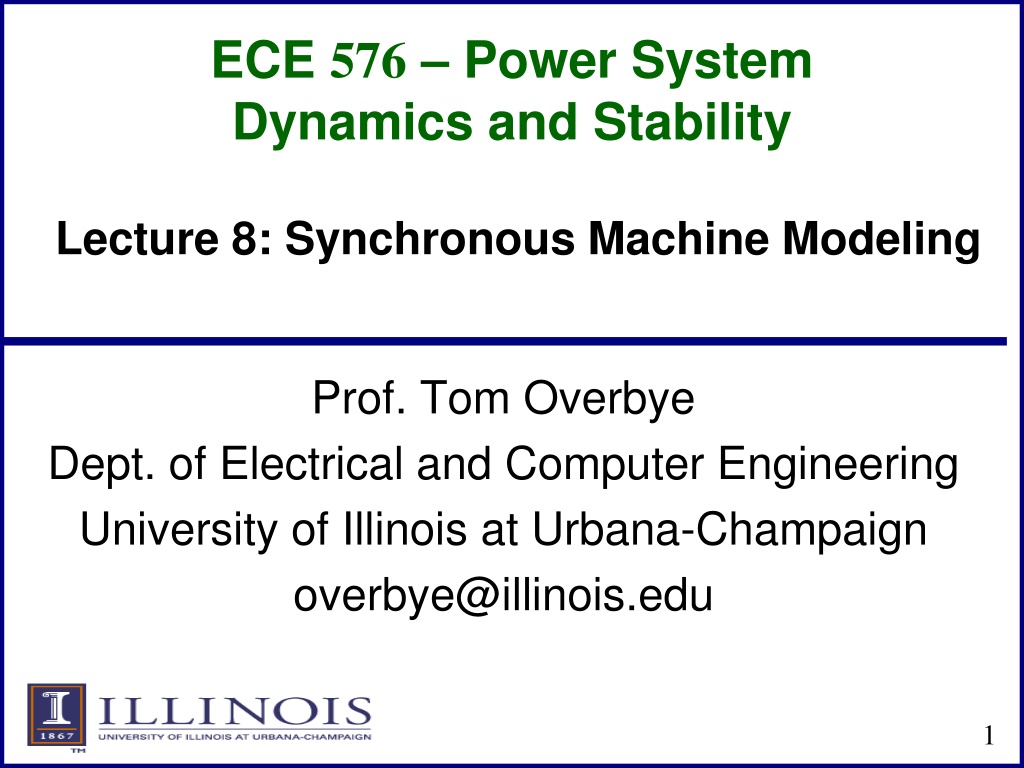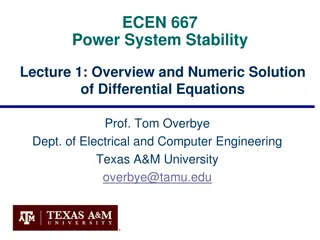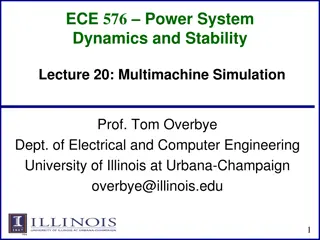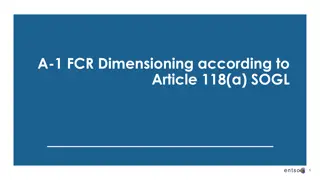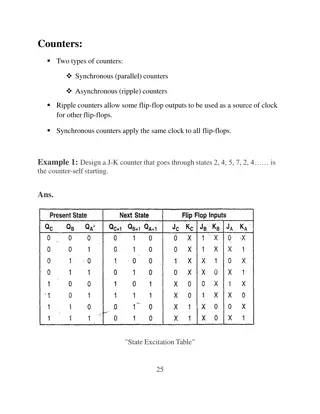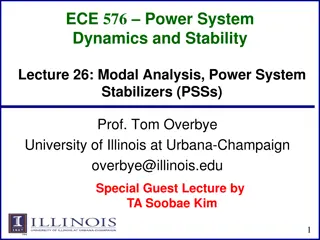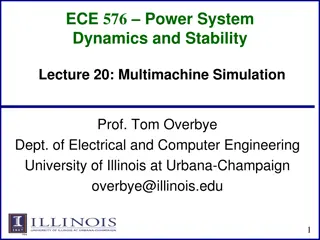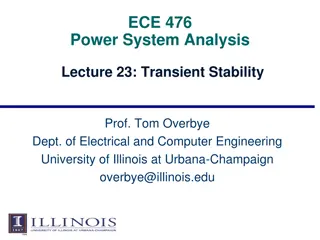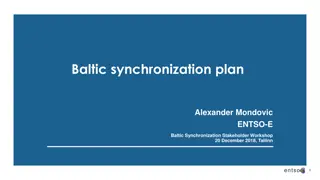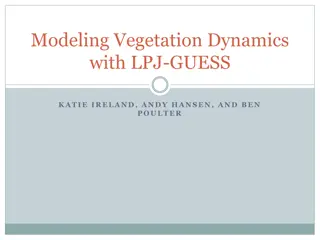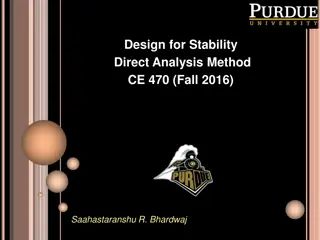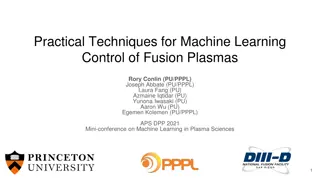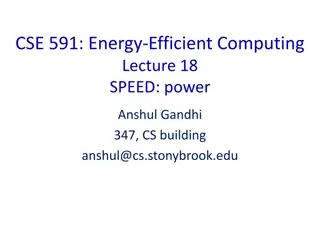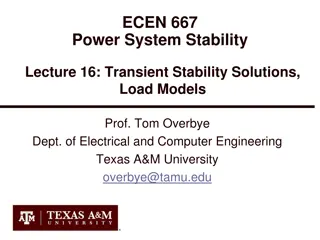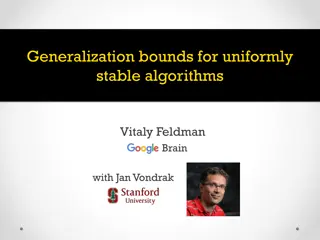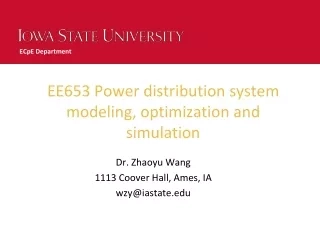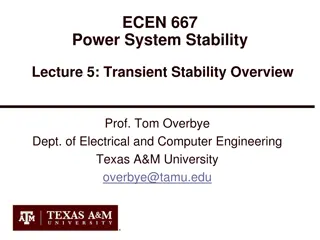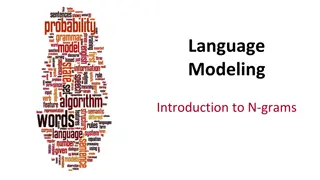Power System Dynamics and Stability Lecture 8: Synchronous Machine Modeling
This lecture focuses on modeling synchronous machines for power system dynamics and stability analysis. Topics include load modeling, dynamic load models, and comparing results with different load characteristics. The content also covers commercial transient stability packages and adding detailed load models in PowerWorld for improved analysis.
Download Presentation

Please find below an Image/Link to download the presentation.
The content on the website is provided AS IS for your information and personal use only. It may not be sold, licensed, or shared on other websites without obtaining consent from the author. Download presentation by click this link. If you encounter any issues during the download, it is possible that the publisher has removed the file from their server.
E N D
Presentation Transcript
ECE 576 Power System Dynamics and Stability Lecture 8: Synchronous Machine Modeling Prof. Tom Overbye Dept. of Electrical and Computer Engineering University of Illinois at Urbana-Champaign overbye@illinois.edu 1
Announcements Homework 2 is posted on the web; it is due on Thursday Feb 20 Skim Chapter 4; we'll be returning to this in greater detail later Commercial transient stability packages uses a number of different models to represent types of exciters and governors Read Chapter 5 and Appendix A 2
Load Modeling The load model used in transient stability can have a significant impact on the results By default PowerWorld uses constant impedance models but makes it very easy to add more complex loads. The default (global) models are specified on the Options, Power System Model page. These models are used only when no other models are specified. 3
Load Modeling More detailed models are added by selecting Stability Case Info from the ribbon, then Case Information, Load Characteristics Models. Models can be specified for the entire case (system), or individual areas, zones, owners, buses or loads. To insert a load model click right click and select insert to display the Load Characteristic Information dialog. Right click here to get local menu and select insert. 4
Dynamic Load Models Loads can either be static or dynamic, with dynamic models often used to represent induction motors Some load models include a mixture of different types of loads; one example is the CLOD model represents a mixture of static and dynamic models Loads models/changed in PowerWorld using the Load Characteristic Information Dialog Next slide shows voltage results for static versus dynamic load models Case Name: WSCC_9Bus_Load 5
WSCC Case Without/With Complex Load Models Below graphs compare the voltage response following a fault with a static impedance load (left) and the CLOD model, which includes induction motors (right) 1.05 1.1 1 0.95 0.9 0.85 0.8 0.75 0.7 0.65 0.6 0.55 0.5 0.45 0.4 0.35 0.3 0.25 0.2 0.15 0.1 0.05 1 0.9 0.8 0.7 0.6 0.5 0.4 0.3 0.2 0.1 0 0 0 1 2 3 4 5 6 7 8 9 10 0 1 2 3 4 5 6 7 8 9 10 V (pu)_Bus Bus 2 V (pu)_Bus Bus 5 V (pu)_Bus Bus 8 V (pu)_Bus Bus 3 V (pu)_Bus Bus 6 V (pu)_Bus Bus 9 V (pu)_Bus Bus 4 V (pu)_Bus Bus 7 V (pu)_Bus Bus1 V (pu)_Bus Bus 2 V (pu)_Bus Bus 5 V (pu)_Bus Bus 8 V (pu)_Bus Bus 3 V (pu)_Bus Bus 6 V (pu)_Bus Bus 9 V (pu)_Bus Bus 4 V (pu)_Bus Bus 7 V (pu)_Bus Bus1 g f e d c b g f e d c b g f e d c b g f e d c b g f e d c b g f e d c b g f e d c b g f e d c b g f e d c b g f e d c b g f e d c b g f e d c b g f e d c b g f e d c b g f e d c b g f e d c b g f e d c b g f e d c b 6
Under-Voltage Motor Tripping In the PowerWorld CLOD model, under-voltage motor tripping may be set by the following parameters Vi = voltage at which trip will occur (default = 0.75 pu) Ti (cycles) = length of time voltage needs to be below Vi before trip will occur (default = 60 cycles, or 1 second) In this example as you move the clearing time from 0.033 up to 0.040, you will see the motors tripping out on buses 5, 6, and 8 (the load buses) this is especially visible on the bus voltages plot. These trips allow the clearing time to be a bit longer than would otherwise be the case. Set Vi = 0 in this model to turn off motor tripping. 7
37 Bus System Next we consider a slightly larger, 9 generator, 37 bus system. To view this system open case GSO_37Bus. The system one-line is shown below. To see summary listings of the transient stability models in this case select Stability Case Info from the ribbon, and then either TS Generator Summary or TS Case Summary SLACK345 A MVA 75 MW 49 Mvar A MVA slack 1.03 pu RAY345 A SLACK138 A A MVA 1.03 pu TIM345 MVA MVA 1.02 pu RAY138 A A A MVA 1.03 pu 1.02 pu MVA TIM138 MVA 1.01 pu 33 MW 13 Mvar 18 MW 5 Mvar A 16.0 Mvar 1.02 pu MVA A A RAY69 74 MW MVA A MVA 17 MW 3 Mvar A 1.02 pu TIM69 PAI69 27 Mvar MVA 1.01 pu 1.01 pu GROSS69 A MVA A 23 MW 7 Mvar MVA A A MVA FERNA69 WOLEN69 MVA 1.00 pu MVA 23 MW 7 Mvar A MORO138 HISKY69 MVA A A 4.8 Mvar 12 MW 5 Mvar A MVA MVA 20 MW 6 Mvar 1.00 pu MVA A 1.00 pu BOB138 PETE69 A DEMAR69 MVA 1.01 pu A A HANNAH69 MVA 58 MW 40 Mvar MVA MVA 45 MW 12 Mvar 23 MW 6 Mvar 1.01 pu BOB69 A 29.1 Mvar MVA 18.2 Mvar UIUC69 1.00 pu 1.00 pu 140 MW 45 Mvar 56 MW A 12.8 Mvar 13 Mvar A LYNN138 1.02 pu MVA 16 MW -14 Mvar A MVA 14 MW A MVA A 58 MW 36 Mvar 4 Mvar A 1.01 pu BLT138 MVA 1.00 pu MVA MVA 1.00 pu AMANDA69 A A A SHIMKO69 HOMER69 MVA 27 MW 3 Mvar MVA A MVA 7.3 Mvar 1.01 pu BLT69 MVA 1.01 pu A 15 MW 14 MW 3 Mvar A MVA 5 Mvar HALE69 75 MW 35 Mvar A 1.01 pu MVA MVA A A 36 MW 10 Mvar A A 1.01 pu 60 MW 12 Mvar 7.3 Mvar MVA MVA MVA A A MVA 1.01 pu 1.00 pu PATTEN69 0.0 Mvar MVA MVA A 23 MW 3 Mvar ROGER69 MVA 1.01 pu WEBER69 LAUF69 1.02 pu 23 MW 6 Mvar 22 MW 15 Mvar 10 MW 5 Mvar A A A 28 MW 6 Mvar 150 MW -14 Mvar MVA MVA MVA 1.02 pu LAUF138 1.01 pu SAVOY69 38 MW 4 Mvar 1.01 pu JO138 JO345 1.01 pu BUCKY138 A MVA A 1.01 pu SAVOY138 MVA A A A 150 MW -2 Mvar MVA MVA MVA 150 MW -2 Mvar A A 1.02 pu 1.03 pu MVA MVA 8
Transient Stability Case and Model Summary Displays Right click on a line and select Show Dialog for more information. 9
37 Bus Case Solution 60 Graph shows the generator frequency response following the loss of one generator 59.98 59.96 59.94 59.92 59.9 59.88 59.86 59.84 59.82 59.8 59.78 59.76 59.74 59.72 59.7 59.68 59.66 59.64 59.62 59.6 0 1 2 3 4 5 6 7 8 9 10 11 12 13 14 15 16 17 18 19 20 Speed_Gen WEBER69 #1 Speed_Gen JO345 #2 Speed_Gen LAUF69 #1 Speed_Gen ROGER69 #1 Speed_Gen BLT69 #1 Speed_Gen JO345 #1 Speed_Gen SLACK345 #1 Speed_Gen BOB69 #1 Speed_Gen BLT138 #1 g f e d c b g f e d c b g f e d c b g f e d c b g f e d c b g f e d c b g f e d c b g f e d c b g f e d c b 10
Stepping Through a Solution Simulator provides functionality to make it easy to see what is occurring during a solution. This functionality is accessed on the States/Manual Control Page Transfer results to Power Flow to view using standard PowerWorld displays and one-lines See detailed results at the Paused Time Run a Specified Number of Timesteps or Run Until a Specified Time, then Pause. 11
Summary So Far The model as developed so far has been derived using the following assumptions The stator has three coils in a balanced configuration, spaced 120 electrical degrees apart Rotor has four coils in a balanced configuration located 90 electrical degrees apart Relationship between the flux linkages and currents must reflect a conservative coupling field The relationships between the flux linkages and currents must be independent of shaft when expressed in the dq0 coordinate system 12
Two Main Types of Synchronous Machines Round Rotor Air-gap is constant, used with higher speed machines Salient Rotor (often called Salient Pole) Air-gap varies circumferentially Used with many pole, slower machines such as hydro Narrowest part of gap in the d-axis and the widest along the q-axis 13
Assuming a Linear Magnetic Circuit If the flux linkages are assumed to be a linear function of the currents then we can write i i i The rotor self- inductance matrix Lrr is independent of shaft a a ( ) ( ) shaft shaft L L b b ss sr c c = i i fd fd ( ) ( ) 1 1 i i d d shaft shaft L L rs rr 1 1 q q 2 2 q q 14
Inductive Dependence on Shaft Angle L12 = 0 L12 = + maximum L12 = - maximum 15
Stator Inductances The self inductance for each stator winding has a portion that is due to the leakage flux which does not cross the air gap, Lls The other portion of the self inductance is due to flux crossing the air gap and can be modeled for phase a as + P cos( ) L L A B shaft Mutual inductance between the stator windings is modeled as 1L L P offset 2 The offset angle is either 2 /3 or -2 /3 + cos( ) A B shaft 16
Conversion to dq0 for Angle Independence i i i d d q q 1 dqo sr T L o o dqo ss dqo T L T = i i fd fd 1 1 i i d d 1 L rs dqo L T rr 1 1 q q 2 2 q q 17
Conversion to dq0 for Angle Independence ( 3 2 3 2 ( 3 2 3 2 L i ) 3 2 3 2 = + + + L L i sfd fd L i 1 1 s d d L i ( ) + , L L L d s md d md A B = + + sfd d L i L i L i 1 1 fd d d fd fdfd fd ( ) L L L mq A B = + + s d d L i L ) i 1 1 1 d d d L i 1 1 1 d fd d fd For a round rotor machine LB is small and hence Lmd is close to Lmq. For a salient pole machine Lmd is substantially larger = + + + L L i 1 1 s q q L i s q L i 2 2 q s mq q q = + + s q q L i 1 1 1 q q q L i 1 2 q q L i 1 1 2 q q = + + s q q L i 1 2 1 q q q L i 2 2 q q L i 2 2 2 q q = o s o 18
Convert to Normalized at f = s Convert to per unit, and assume frequency of s Then define new per unit reactance variables , s md BDQ BDQ Z Z L L X X Z Z L L X X Z Z L L L s mq , s s s md X X X mq Z BDQ L L s fdfd s fd1d sfd , , s 1d1d X fd 1d fd1d Z L BFD B1D BFD L Z s1d L L s 1q1q s 2q2q s 1q2q s1q , , X 1q 2q 1q2q B1Q B2Q X B1Q s2q , X X X X X fd fd md 1d 1d md , X X X X X X 1q 1q + mq , 2q 2 q X mq + X X X X X d s md q s mq 19
Example Xd/Xq Ratios for a WECC Case 20
Normalized Equations ( ) = + + X I X I X I 1 d d d I md X fd I md d ( ( ) ) = + + X c X I 1 fd md d fd fd d + md d = = + X I c X I X I 1 c 1 1 d md d d md fd d d X X 1 1 2 q q X fd d X , c c 1 X d q d ( ) md mq + + I X I X I 1 2 q q q mq q mq q ( ( ) ) = + + X I X I c X I 1 1 1 2 q mq q q q q mq q = + + X I c X I X I 2 c 1 2 2 q mq q q mq q q q 1 q ( ) = X I o s o 21
Key Simulation Parameters The key parameters that occur in most models can then be defined the following transient values 1 1 1 X X 2 md X X These values will be used in all the synchronous machine models d + = X X X s d + fd md fd 2 mq X X 1 q + = X X X s q 1 1 + 1 q X X 1 mq q X In a salient rotor machine Xmq is small so Xq = X'q; also X1q is small so T'q0 is small Xfd R 1 R q do qo , T T 1 s fd s q 22
Example X'q/Xq Ratios for a WECC Case About 75% are Clearly Salient Pole Machines! 23
Key Simulation Parameters And the subtransient parameters These values will be used in the subtransient machine models. It is common to assume X"d = X"q 1 1 d + X X s 1 1 + + X X X 1 md fd d 1 1 q + X X s 1 1 + + X X X 1 2 mq q q 1 R 1 1 R 1 do qo = + = + , T X T X 1 2 d q 1 1 1 1 + + 1 2 s d s q X X X X 1 1 md d mq q 24
Internal Variables Define the following variables, which are quite important in subsequent models Xmd Xfd Xmq Xq Xmd Rfd Hence E'q and E'd are scaled flux linkages and Efd is the scaled field voltage Eq fd Ed 1 q 1 E V fd fd 25
Dynamic Model Development In developing the dynamic model not all of the currents and fluxes are independent In the book formulation only seven out of fourteen are independent Approach is to eliminate the rotor currents, retaining the terminal currents (Id, Iq, I0) for matching the network boundary conditions 26
Rotor Currents Use new variables to solve for the rotor currents ( ( ) ) ( ( ) ) d d d X X X X X X X X s d d q = + + X I E 1 d d d s d s 1 ( )( ) q d = + I E X X I I 1 fd d d d X md X X d d X ( ) d q = + I X X I E 1 1 d d s d ( ) 2 d X s 27
Rotor Currents ( ( ) ) ( ( ) ) q q q X X X X s q q d = + X I E 2 q q X X X X q s q s 1 ( )( ) d q = + I E X X I I 1 2 q q q q X mq X q q X ( ) q d = + + I X X I E 2 2 q q s q ( X ) 2 q X X s ( ) = I o s o 28
Final Complete Model 1 d = + + d R I V s d q d dt s s d 1 q = + R I V s q d q dt s s 1 d = + o R I Vo s o dt s q d d dE dt X X ( ) ( ) ( ) do q d d q = + + T E X X I X X I E E 1 d d d s d fd ( ) 2 d X X s q q d X X ( ) dE dt ( ) ( ) qo d q q d = + + + T E X X I X X I E 2 q q q s q ( ) 2 q X X s 29
Final Complete Model d ( ) do q d 1 d = + T E X X I 1 d s d dt d ( ) 2 q qo d q = T E X X I 2 q s q dt d = s dt 2 H d ( ) TFW is the friction and windage component that we'll consider later = T d q I q d I T M FW dt s 30
Final Complete Model ( ( ( ( ) ) ( ( ( ( ) ) d d X X X X X X X X s s d d q = + + X I E 1 d d d s d s ) ) ) ) q X X X X q s q q q d = + X I E 2 q q X X X X q s q s = X I o s o 31
Single-Machine Steady-State Previous derivation was done assuming a linear magnetic circuit We'll consider the nonlinear magnetic circuit (section 3.5) but will first do the steady-state condition (3.6) In steady-state the speed is constant (equal to s), is constant, and all the derivatives are zero Initial values are determined from the terminal conditions: voltage magnitude, voltage angle, real and reactive power injection 32
Single-Machine Steady-State ( ) = = = = + + + + 0 R I V = d d s d q d = = = s E X I d q X I 0 R I V s q d q q q d E q 0 0 R I V s o E o X X I ( ) q d + o s o X I E d d fd I ( ) = + ) 0 E ( X X The key variable we need to determine the initial conditions is actually , which doesn't appear explicitly in these equations! 1 d q d s d d q = + 0 E X X I q q ( ) d = 0 E X X I 2 q q s q = 0 s ( ) = 0 T d q I q d I T m FW 33
Field Current The field current, Ifd, is defined in steady-state as = / I E X fd fd md However, what is usually used in transient stability simulations for the field current is I X fd md So the value of Xmd is not needed 34
Determining without Saturation In order to get the initial values for the variables we need to determine We'll eventually consider two approaches: the simple one when there is no saturation, and then later a general approach for models with saturation To derive the simple approach we have = = + + V R I E + X I d s d R I d E q q X I q V q s q d d 35
Determining without Saturation Recalling the relation between and the stator values ( ( d q s I jI e I e ) j s ( /2) j + = V jV e V e d q s ) j s ( /2) j + = We then combine the equations for Vd and Vq and get ( where = + ) ( )( ) ( /2) ( /2) j j + = + + + V jV e R jX I jI e E d q s q d q ( ) ( /2) j E j X X I E e q d d q 36
Determining without Saturation ( ) ) /2 j = Since j e ( j d q = + E X X I E e q d Then in terms of the terminal values = + + ( ) E V R jX I as s q as = The angle on E 37
